NEET Biology Organisms and Populations Main Branches Of Ecology
Ecology:
Science examines the interaction between an organism and its external environment.
- The word was introduced by Reiter (1865) and subsequently defined by Haeckel (1866) as the examination of reciprocal interactions between organisms and their environment.
- The term ecology originates from the Greek words oikos, meaning “place to live,” and logos, meaning “study.” E.P. Odum characterized it as the examination of the structure and function of nature.
Organisms And Populations NEET Notes
Autoecology. Study of an individual organism or a particular species in relation to its environment.
Synecology. Study of groups of organisms (communities) in relation to their environment.
Conservation Ecology. It deals with the proper management of natural resources for the benefit of human beings.
Production Ecology. It deals with the gross and net production of organic matter content in different kinds of ecosystems so that proper land management may be achieved.
Ecological Energetics. It is concerned with the energy conservation and flow in the organisms within the ecosystem.
Radiation Ecology. It deals with the study of radioactive substances and radiation in the surroundings.
Space Ecology. This is concerned with a possible visit to and return from neighboring planets and its effects.
Estuarine Ecology. It deals with the study of organisms in estuarine points.
Read and Learn More NEET Biology Notes
Microbial Ecology. It is concerned with the studies of various principles that govern the distribution of microorganisms as algae, fungi, bacteria, etc. in nature.
Gynecology. Study of ecological adaptations in relation to genetic variability.
Paleoecology. Study of the relationship between organisms and the environment of the past.
Applied Ecology. Application of ecological concept for human welfare.
Silviculture. Study of maintenance and preservation of forests.
Organisms And Populations NEET Notes
System Ecology and Ecosystem Modeling. Data on ecological investigation are being computerized to formulate and describe the structure and function of ecosystems by preparing verbal, graphic, and mathematical models and equations and utilization in various ecological investigations.
Statistical Ecology. It deals with statistical studies on populations, sampling techniques, and community problems.
Pollution Ecology. It deals with the study of the effects of environmental pollutants on organisms and other objects.
Demoecology. Study of a population in relation to its environment.
Bioecology. Shelford and Clements used the term bioecology for the integrated study of plant ecology and animal ecology.
NEET Biology Organisms and Populations Level Of Organisation
Organism: Basic unit of study in ecology.
Population: Group of individuals of the same species inhabiting a given area.
Community Assemblage of different kinds of populations, living under the same set of environmental conditions interacting with each other. A biological community has a distinct species composition and structure.
Ecosystem A community integrated with its physical environment through the exchange of energy and recycling of nutrients.
Biome It is an ecosystem spread over a large area and defined by specified latitude, precipitation, temperature, flora, and fauna.
Biosphere Sum total of all biomes form a biosphere (The inhabited part of the earth is known as a biosphere.)
Landscape It is a part of the geographical region which is well-demarcated and consists of a large number of different types of ecosystems.
NEET Organisms And Populations Chapter Notes
NEET Biology Organisms and Populations Environment, Habitat, And Niche
The Environment Sum total of all biotic and abiotic factors that surround and potentially influence an organism is termed environment. It can be studied on
Large Scale Climate
Small Scale Microclimate
Organisms interact with their environment at several spatial and time scales. for example,
- Bacteria – fraction of cm³
- Tree-large area.
Weather: Short-term property of the atmosphere (such as temperature, pressure, humidity, rainfall, sunshine, cloud cover, and wind) at a given place and time which reflects hourly, daily, or weekly changes that constitute weather.
Weather changes with change in any of these atmospheric factors and has little impact on the flora and fauna of a place.
Climate average weather of an area is known as climate. It is affected by two factors
- Temperature
- Rainfall
Both these factors are determined by input of solar radiations which is turn depend on the latitude of that particular region.
NEET Biology Organisms And Populations Important Points
Climatic Zones
- Tropical (0° – 20° latitude)
- Sub-tropical (20° – 40° latitude)
- Temperate (40° – 60° latitude)
- Arctic and Antarctic (60° – 80° latitude)
Temperature decreases with an increase in latitude/altitude
NEET Biology Organisms And Populations
In Tropical Region Mountain: All 4 climatic Zones
- Alpine
- Temperature
- Sub-tropical
- Tropical
Temperature Zone Mountain: 2 climatic zones
- Alpine
- Temperate
Microclimate Climate conditions prevailing at a local scale or Immediate surrounding of plants and animals. for example: the interior of a forest is more humid than a nearby nonforested area.
Habitat Place occupied by an entire biological community for example: a pond, desert, river, or valley.
Microhabitat Part of habitual having a specific property for example edge of a pond, forest floor, or tree trunk.
Niche Or Ecological Niche (Grinnel) Refers to a specific place in a habitat occupied by a species where it can show all its activities and is characterized by the type of food available, amount of light available, and range of tolerance.
A habitat supports many species and has many niches but no two species can occupy the same niche.
Ecological Equivalents: Two different types of organisms which are living in different habitats but occupy the same niche for example both owls and cats feed on shrews and mice.
NEET Biology Organisms And Populations Organism And Its Environment
Ecology at the orgasmic level is also called physiological ecology because it explains how different organisms are adapted to their environment for survival and reproduction.
The climate of a particular region is affected by two factors i.e. temperature, and precipitation (rainfall and snowfall). Annual variations in the intensity and duration of temperature (seasons) and annual variations in precipitation are responsible for the formation of major biomes like desert rainforests, deciduous forests, and tundra.

- Regional and local variations within each biome form a variety of habitats (places occupied by a population or an entire biological community) of India.
- On this planet, life not only exists in favorable habitats but also in extreme and harsh habitats such as the Rajasthan desert, rain-soaked Meghalaya forests, streams, deep oceans, trenches, high mountain tops, boiling thermal springs, compost pits, permafrost polar regions and even in our intestines.
NEET Biology Organisms And Populations Important Points
The most important environmental factors that cause of physical and chemical conditions of different habitats are:
- Temperature
- Water
- Light
- Soil
Habitat includes not only abiotic (physio-chemical) components but also biotic components like pathogens, parasites, predators, and competitors of the organisms with which they interact constantly.
Over some time, organisms had through natural selection evolved adaptations for their survival and reproduction in different types of habitats.
NEET Biology Organisms and Populations Major A Biotic Factors
Temperature: It is the degree of hotness and coldness of a substance. It is the most ecologically relevant environmental factor. It is affected by altitude, latitude, topography, and Vegetation.
- Tropical zone > 24°C Megatherm
- Subtropical zone 17° – 24°C Mesotherm
- Temperature 7° – 17°C Microtherm
- Arctic/Antarctic <7° Hekistotherm
Temperature varies seasonally and decreases progressively from the equator towards the poles and from plains to the mountain top. There are however unique habitats, such as thermal springs and deep-sea hydrothermal vents where average temperature exceeds 100°C.
Temperature governs the geographical distribution of many plants and animals for example,
- Mango trees do not and cannot grow in temperate countries like Canada and Germany.
- Snow leopards are not found in Kerala forests.
- Tuna fish are rarely found beyond tropical latitudes in oceans.
Temperature greatly affects living organisms because it affects the kinetics of enzymes and through it the basal metabolism, activity, and other physiological functions of the organisms.
- Organisms that can endure large fluctuations in temperature and can tolerate a wide range of temperatures are called eurythermal, for example, Artemesia, plants of temperate regions.
- Most of the organisms are restricted to a narrow range of temperatures, such organisms are called steno thermals, for example, palms (seashore), and plants in warm tropics.
- The levels of thermal tolerance of different species determine to a large extent their geographical distribution. In recent years, as the average global temperature is gradually increasing it is going to affect the distributional range of many species, particularly thermals.
Effects Of Temperature: Temperature affects – growth, metabolism, reproduction, sex ratio distribution coloration behavior, and morphology.
Water: Next to temperature, water is the most important factor influencing the life of organisms. Life is not possible without water.
Plants and animals show modifications according to the availability of water in the area and the requirements of conserving the obtained water. Plants in dry areas are called xerophytes. These plants develop modifications to increase water absorption and reduce transpiration.
NEET Biology Organisms And Populations
NEET Biology Organisms and Populations Soil Profile
It is the vertical section of the soil showing various layers or horizons. It consists of the following horizons:
- Horizon ‘A’. It is the uppermost horizon of the soil called as topsoil. It shows maxi-mum biological activity. Due to having most of the plant’s roots, soil flora, and fauna in this layer, its thickness varies from a few centimeters to 3 meters. It is differentiated into 4-sublayers. The superficial sublayers of litter and duff are designated as Aoo and Ao. These are sometimes excluded from horizon ‘A’ and included under horizon ‘O’ of their own. Horizon A is subdivided into the following sublayers:
- Aoo(O1)(Litter layer). It is the uppermost sublayer containing freshly fallen undecomposed organic debris of dead leaves, bark, flowers, fruits, and animal remains.
- Ao(O2)(Duff layer). Below Aoo, the organic matter is found under different stages of decomposition. Small insects, bacteria, and fungi are in abundance.
- A1(Humus layer). It is dark and rich in organic matter which is finely divided, amorphous, dark brown, black colored, and mixed with mineral matter forming humus.
- A2 This region is of light color and has poor inorganic matter. Mineral matter has leached down due to heavy rains.
- Horizon ‘B’ or Sub-soil. It is rich in mineral matter and very poor in organic matter. Biological activity is very little due to poor aeration. Roots of only large trees and shrubs reach in this region.
- Horizon ‘C’ or Zone of regolith. It is composed of partly weathered parental rocks.
- Horizon ‘R’. It is the lowermost layer of soil, consisting of rocks (unweathered) called Sub-Soil.
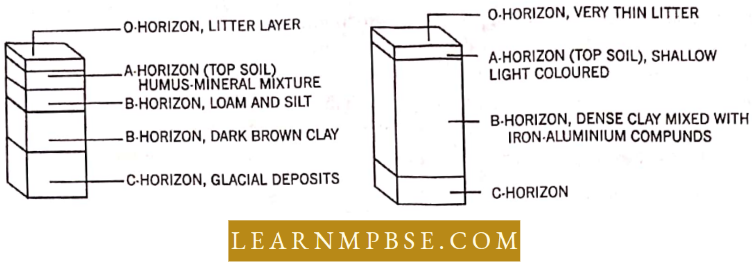
NEET Biology Organisms And Populations Revision Notes
NEET Biology Organisms and Populations Responses To Abiotic Factors (Organisms Response)
Organisms are often found living under varied environmental conditions which will not permit all biochemical reactions and physiological functions to proceed with maximal efficiency and so cannot enhance the overall fitness of the species.
- During the course of millions of years of their existence, many species have evolved a relatively constant internal environment, despite varying external environmental conditions. This constancy may be in terms of optimal temperature and osmotic concentrations of body fluids.
- A process by which the organisms, keep the internal environment constant is called homeostasis.
- To further explain this concept, if an example is taken of a person who is able to perform best when the temperature is 25°C and wishes to maintain it so, even when it is hot or cold outside can be achieved by using an air-conditioner is summer and heater in winters.
- Then performance would be always maximal, regardless of the weather around. This homeostasis is obtained through technology. It occurs through an expenditure of external energy.
- Organisms maintain homeostasis through physiological means which requires an expenditure of internal energy of the body. However, all organisms are not able to spend so much energy on maintaining homeostasis.
- So, to meet stressful abiotic conditions organisms regulate, conform, migrate, and suspend their activities.
Regulate: Some organisms are able to maintain homeostasis by physiological means which ensures constant body temperature, constant osmotic concentration, etc. All birds and mammals, and a very few vertebrate and invertebrate species are indeed capable of such regulation (thermoregulation and osmoregulation).
- Animals having a regulated body temperature are called endothermic homoithermal or warm-blooded animals. The success of mammals is largely due to their ability to maintain a constant body temperature and because of this they thrive well whether they live in Antarctica or in the Sahara desert.
- The mechanisms used by most mammals to regulate their body temperature are similar to the ones that we humans use. We maintain a constant body temperature of 37°C. In summer, when the outside temperature is more than our body temperature, we sweat profusely.
- In winter when the temperature is much lower than 37 °C, we start to shiver, a kind of exercise which produces heat and raises the body temperature. Plants, on the other hand, do not have such mechanisms to maintain internal temperatures.
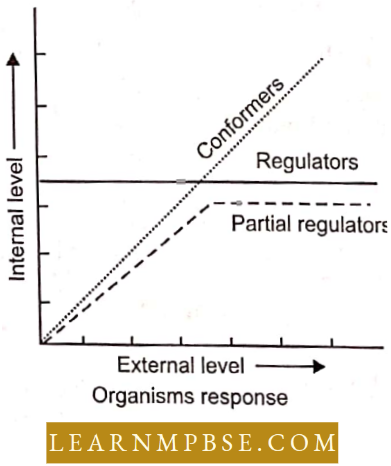
Conform: the majority of animals (99%) and nearly all plants cannot maintain a constant internal environment. They do not have a temperature-regulating mechanism. The temperature of such organisms changes with the surrounding temperature. Such animals arc called ectothermit poikilothermal or cold-blooded animals.
- In aquatic animals, the osmotic concentration of the body fluid changes with that of the ambient water osmotic concentration. Such plants and animals that change their internal environment in response to the external environment are called conformers.
- Although regulators are most benefitted hut still conformers have not evolved to become regulators. It is comparable to the situation, where a person will sweat in summer because cannot afford an air-conditioner so will continue with sub-optimal performance in the hot summer months.
- Thermoregulation is energetically expensive for many organisms. This is particularly true for small animals like shrews and hummingbirds. Heat loss or heat gain is a function of surface area.
- Since small animals have a larger surface area relative to their volume, they tend to lose body heat very fast when it is cold outside; they have to expend much energy to generate body heat through metabolism.
- This is the main reason why very small animals are rarely found in polar regions. During the course of evolution the costs and benefits of maintaining a constant internal environment the taken into consideration.
- There are some organisms that are intermediate between conformers and regulators. They are able to maintain homeostasis up to a certain limit beyond which they behave like conformers. They are known as partial regulators.
- If the stressful external conditions arc localized or remain only for a short duration, the organisms have two other alternatives.
Migrate: The organism can move away temporarily from the stressful habitat to a more hospitable area and return when the stressful period is over. Like a person moving from Delhi to Shimla for the duration of summer.
Many animals, particularly birds, during winter, undertake long-distance migrations to more hospitable areas. Every winter the famous Keoladeo National Park (Bharatpur) in Rajasthan receives thousands of migratory birds coming from Siberia and other extremely cold northern regions.
Organisms And Populations NEET Notes
Suspend (Stop For A Time): In bacteria, fungi, and lower plants, various kinds of thick-walled spores are formed which help them to survive unfavorable conditions and germinate only on the availability of a suitable environment.
In higher plants, seeds and some other vegetative reproductive structures serve as means to tide over periods of stress besides helping in dispersal. They do so by reducing their metabolic activity and going into a state of dormancy. In animals, the organism, if unable to migrate, might avoid the stress by escaping in time. It is of three types :
- Hibernation i.e. winder sleep for example Bears.
- Aestivation i.e. summer sleep for example Some snails and fish.
- Diapause: Under unfavorable conditions, many zooplankton in lakes and ponds are known to enter diapause a stage of suspended development. Diapause is a stage in the development of certain animals during which developmental growth is suspended during winter when days are short.
Population Ecology NEET Notes
NEET Biology Organisms and Populations Ecological Levels Of Organisation
The ecological levels of the organization are an organism, population, community, ecosystem, biome, and biosphere.
- Organisms are the basic unit of study in ecology. At the organismic level, we intend to study form, physiology and behavior, distribution, and adaptations in relation to environmental conditions.
- Species is a group of organisms interbreeding among themselves to produce fertile young ones of their own kind.
- Population Level. Individuals of a species living in an area form a freely interbreeding group called a population, for example, all individuals of elephants living in an area constitute a population.
- Community Level. Populations of different species present in an area develop interdependence and interactions to form a well-knit group called a community or biotic community.
- Ecosystem Level. The biotic community of a segment of nature interacts with abiotic factors to form an ecosystem. An ecosystem is generally a self-sufficient unit that has its own flow of energy, biogeochemical cycles, and system of controls.
- A landscape is a unit of land with a natural boundary having a mosaic of patches.
- Biome Level. A number of ecosystems are associated with forming a bigger organization specific to a geographic area or climate. It is called a biome. Some examples of biomes are deserts, temperate deciduous forests, tropical rainforests, etc.
- Environment is sum total of all biotic and abiotic components.
- The short-term properties of the atmosphere such as temperature, pressure, humidity, rainfall, sunshine, cloud cover, and wind at a given place and time are termed weather.
- Climate. It is the average weather of an area.
- Biosphere. It is the largest biological system on a global scale which occurs in the whole living mantle of the earth. The biosphere has the highest level of organization. It is made of several biomes.
- The different climatic regions are tropical, subtropical, temperate arctic, and antarctic.
- Habitat is the natural place of living of an organism.
Differences Between Habitat And Environment
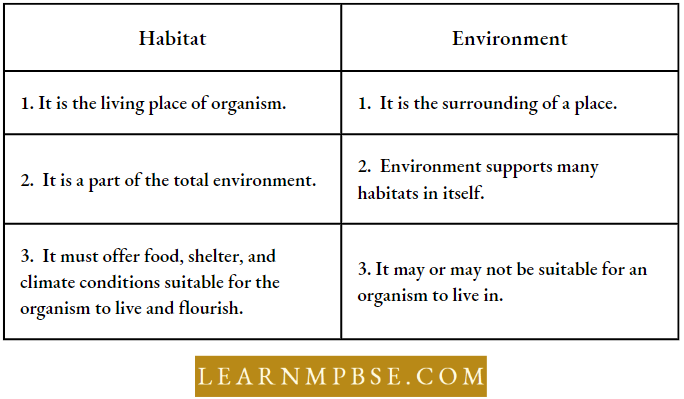
Differences Between Habitat And Microhabitat
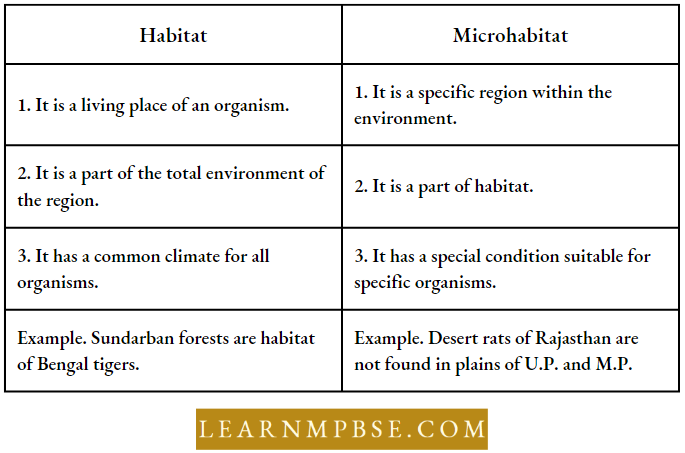
Microclimate. It represents the climatic conditions that prevail at a local scale, or in areas of limited size such as the immediate surroundings of plants and animals. Microclimate generally differs from the prevailing regional climatic conditions. For example, in a forest, dense foliage reduces the amount of light reaching the ground.
This also results in a changed air temperature profile. The daytime air temperature inside the forests is lower than outside. Also, the interior of a forest may be more humid than a nearby non-forested area.
Population Ecology NEET Notes
NEET Biology Organisms and Populations Ecological Niche
The ecological Niche of an organism represents the range of conditions that it can tolerate, the resources it utilizes, and its functional role in the ecological system. The ecological niche involves not only the physical space occupied by an organism, but also its functional role in the community (i.e., a trophic position occupied), and its position in environmental gradients including other conditions of existence. The term ‘niche’ was for the first time used by Grinncl. (1971)
Population Interactions NEET Biology
Kinds Of Ecological Niche
- Trophic Niche. It is associated with the trophic position of an organism. For example. the two aquatic bugs. Corixa and Nototiccta live in the same habitat, i.e., pond but occupy different trophic niches.
- Spatial Or Habitat Niche. It is concerned with the physical space occupied by an organism. The best example of spatial or habitat niche is provided by the distribution of seven species of millipedes in the forest floor of a maple-oak forest (O’Neill, 1967).
- All seven species occur in the same general habitat, i.e., forest floor, and belong to the same trophic level (that is all are decomposers in their role as detrivores). Another example is provided by the three species of fungi colonizing the decaying culms of fodder grass, for example, Setaria glauca.
- These all fungi live in the habitat, the decaying internodes. and they all belong to the same trophic level (decomposers).
- Multifactor Or Hypervolume Niche. Multifactor (hypervolume) niche concept was developed by G.E. Hutchinson (1965) of Yale University. He suggested that if we measure the range of some environmental variable (for example, temperature) over which a particular species can live and reproduce we put this on a graph.
We then do the same for another environmental variable (for example, humidity) and put this on the second axis of the graph. The space that is enclosed will represent the niche of the species.
Since there are a large number (n) of other environmental factors, both abiotic and biotic, that affect the population, the niche is n-dimensional hypervolume, an abstraction since we are able to draw only with respect to three dimensions. This is considered to be the fundamental niche of the species.
Organisms And Populations Class 12 Notes For NEET
NEET Biology Organisms And Populations Environmental Factors And Their Importance To Plants And Animals
Environmental Factors Include:
- Light
- Temperature
- Humidity
- Wind
- Rainfall
- Water
- Atmospheric gases.
- Importance Of Light. It is important for photosynthesis, flowering in plants, bird migration, reproductive activities, biological rhythms, plant growth, metabolism, and periodicity.
- Effect Of Temperature. It is the most important factor affecting almost all activities of organisms. Most organisms can survive in the temperature range of 5°-35° C (except certain bacteria) cyanobacteria, shelled protozoa.
- Importance Of Humidity. It is the number of water vapors present in the atmosphere. Absolute humidity is maximum near the equator and gradually decreases towards the poles. It plays an important role in the life of plants as well as animals.
- It promotes the growth of epiphytes example, orchids, and other plants that support animal life.
- It regulates the evaporation of water from the body of land organisms in transpiration and perspiration.
- Importance Of Wind. Air in motion is called wind. Its direct effects are physical or mechanical while indirect effects are physiological. Wind modifies the humidity. Dry winds diffuse the dwarfing of plants. Wind helps in pollination, and dispersal of fruits and seeds and prevents frost damage.
- Sometimes shrubs and trees are planted to protect the field against wind. Such structures are known as windbreaks or shelter belts. These plants (trees) are planted at 90° to the wind velocity.
- It affects both plants and animals (more effects on plants) in the following ways :
- Strong winds cause soil erosion reducing soil fertility. These also cause desertification by shifting of sand particles to fertile areas.
- These cause lodging (flattening of plants against the ground) of plants like wheat, rice, maize, oats, sugarcane, etc.
- These increase the rates of evaporation and transpiration leading to desiccation which causes dwarfism in the plants.
- Importance Of Rainfall. Rainfall is the source of groundwater and relative humidity (the ratio of the pressure of water vapors in the air to the vapor pressure of the air when saturated with water vapors at the same temperature). The amount of annual rainfall greatly affects the vegetation as well as the animal population of a particular region.
- Importance Of Water. Water is essential for life. It covers more than 70% of the earth’s surface and forms the most extensive habitat for the organisms. Types of plants and animals distributed in water bodies greatly depend upon the nature of water (freshwater or seawater). Land plants derive water from the soil while land animals derive water from pools, ponds, lakes, rivers, springs, etc.
NEET Biology Organisms and Populations Tolerance Factors Determine Distribution Of Species
Range Of Tolerance:
- Biological species exhibit varying degrees of tolerance to environmental variables.
- These components exhibit variability in their impact, and anyone present in minimal quantity may constitute a limiting factor.
- The reaction of an organism to varying gradients of a singular environmental element, such as temperature, sunlight, or nutrient concentration, produces a bell-shaped curve as illustrated.
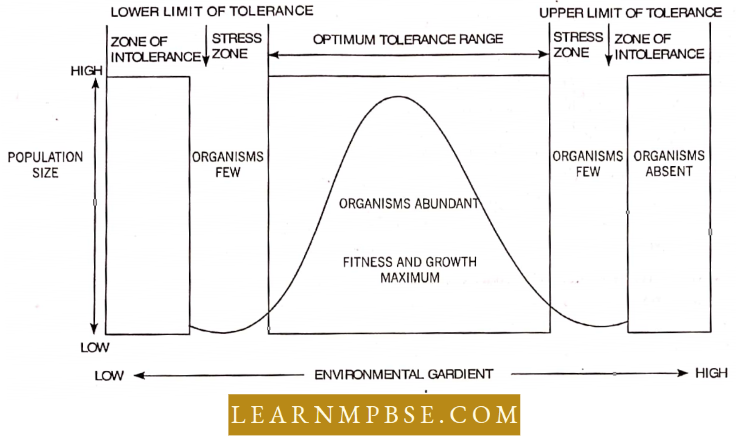
Different Layers Of Atmosphere

Organisms And Populations Class 12 Notes For NEET
NEET Biology Organisms and Populations Zones In The Lake
Shelford proposed the law of tolerance which states that organisms show all grades of tolerance and may have a wide range of tolerance of one factor and a very narrow range for another. Some additional principles of the law of tolerance may be stated as follows:
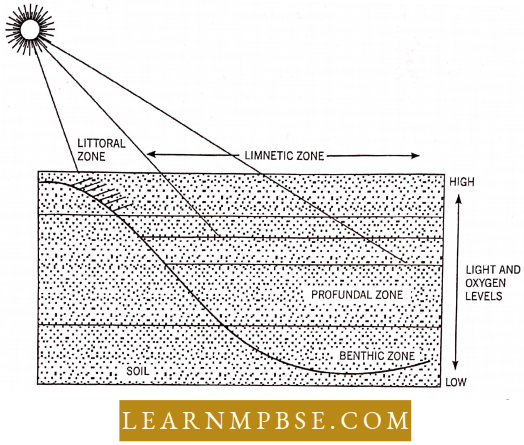
- Organisms may have a wide range of tolerance for one factor and a narrow range for another.
- Organisms with a wide range of tolerance for all the factors are likely to be most widely distributed.
- When conditions are not optimum for a species with respect to a particular environmental factor, the limits of tolerance may be reduced with respect to other factors.
- The limits of tolerance for reproductive individuals, seeds, eggs, embryos, and larvae are usually narrower than for non-reproductive adult plants or animals. For example, adult blue crabs and many other marine animals can tolerate brackish water or fresh water with a high chloride content, but their larvae cannot live in such water and hence, they cannot reproduce in rivers and are not established there permanently.
To describe a species with a narrow range of tolerance for a particular factor, we use the prefix sten., for those with a wide range, we use the prefix eury. The term steno¬thermal and eurythermal, refer to temperature tolerance.
Population Interactions NEET Biology
Liebig’s Law of Minimum. This law states that the growth of the plant is dependent on the amount of the foodstuff which is to it in minimum quantity.
- This statement is later on combined with a law of limiting factors first proposed by the British physiologist.
- Blackmann who investigated the factors affecting the rate of photosynthesis and found that the rate is governed by the level of the one factor operating at a limiting intensity.
- The two concepts combined form the so-called Liebig-Blackmann law.
- However, two additional principles must be added.
- The first is a constraint that Liebig’s law is strictly applicable only under steady-state conditions, i.e., when the inflow of energy and materials balances the outflow.
- The second important consideration is the factor interaction. Thus, a high concentration of some substance, or the action of some factor other than the minimum one, may modify the rate of utilization of the latter. In other words, a high level of one factor or substance will modify the limiting effect of another, a process known as factor interaction.
Organisms And Their Environment NEET
NEET Biology Organisms and Populations Species And Population
The individual is the most concrete entity with a distinct structure and definite function.
- Individual organisms of the same kind form higher units such as family, herd, population, and species.
- Out of the above list, the species and population are the most universal and stable units.
- Species include closely related, morphologically similar individuals who interbreed among themselves to produce the fertile young ones of their own type. Members of species may show individual variation, and sexual dimorphism and may occur as varieties. Polymorphic species have many specialized morphic forms which perform certain functions.
- Different species may be bred artificially, but do not interbreed freely in nature.
- New species evolve from pre-existing species by modifications.
- All species show various cooperative and competitive interactions among their members.
- Many species of animals have a definite home range in which their members find food and mates. Different groups form their territories which are often marked and guided by their members.
a Members of species show intraspecific competition for food, territory, rank, and mate. Cooperation and sexual reproduction are the most fundamental and universal interactions. - Demography is the branch of the study of different aspects of the human population.
A population is a group of organisms of the same species living in a definite area at a given time.
Human Racers
- Negroids
- Dark skin
- Warty Hair
- Thick lips
- Caucasoids
- Light to dark skin
- Blue to dark-eye
- Medium to thin
- Abundant body
- Mongoloid
- Yellow to brown skin
- Brown eye
- Medium to thin lips
- Few body hairs
A set of local populations connected by dispersing individuals is called metapopulation,
- Population has group characteristics, like density, natality, mortality, dispersal, distribution, biotic potential, and growth forms,
- Population density is determined by the total number of individuals per unit space at a specific given time.
- The size of the population is also affected by the natality (birth) and mortality (death) rate. It is also regulated by food, space, disease, and other natural factors, Human populations are characterized by rapid growth, wide distribution, and perennial reproductive activity.
- Socio-cultural factors determine the human populations.
- The inherent maximum capacity of an organism to reproduce or increase in number is termed biotic potential (r).
- The environmental check on population size or its biotic potential is called environmental resistance (k).
- The growth of population can be measured as an increase in its size over a period of time.
- An S-shaped growth curve is obtained for most of populations,
- No single population can live in isolation in a natural environment,
- A biotic community is an association of several populations belonging to different species living in a common environment and interacting with one another,
- The various species in a community share a common environment and are related by direct or indirect interactions.
Organisms And Populations Class 12 Notes For NEET
NEET Biology Organisms and Populations Biotic Community
A population of a single species is not a viable entity or unit by itself. An association of a number of different species in a common environment that can survive in nature is called
biotic communities such as pond communities, forest communities, etc.
Biotic Isolation. The occurrence of organisms living in isolation from other organisms.
Biotic Stability. Tendency in which a biotic community becomes stable.
- It depends upon species diversity; the presence of biological contest, population density, and the carrying capacity of the environment. The larger the number of species present in a biotic community, the more stable it is.
- The relationship between one species and another within a community has evolved through their interactions, based on the requirement and mode of obtaining food and shelter and also on the habits of the species.
Characters In Community Analysis
- Species composition
- Dominance
- Physiognomy and stratification.
- Species diversity
- Keystone and link species.
- Ecotones and Edge effect.
Organisms And Their Environment NEET
Earth’s Vegetation Can Be Divided Into Different Zones Based On Altitude.
- Upto 1800 feet—Tropical rain forest.
- Tropical moist deciduous with 1000-1500 mm rainfall
- Tropical moist evergreen with 2500 mm rainfall.
- 18001—4000 feet—Grassland or desert, savannah
- 4000’—7500 feet—Temperate deciduous forest. Oak is common
- 7500—12000 feet— Coniferous forest (Temperate evergreen forests) for example Pinus, Abies, Picea.
- 12000 feet is regarded as a tree or timberline. Above this height of plants decreases.
- 12500—14500 feet— Alpine vegetation (tundras)
NEET Biology Organisms and Populations Biotic Stability
A biotic community is formed of large numbers and very diverse types of populations of plants, animals, and microbes which differ taxonomically from each other. All these populations are essential for biotic stability
Biotic Stability Definition: Absence of major fluctuations in the population and ability to undergo homeostasis after a disturbance). So stability amongst diversity is an important feature of a biotic community.
Elton (1958) stated that the stability of a biotic community is mainly governed by the number of species in it and the interactions between them. The larger the number of species in a community, the more stable it will be because:
- These provide alternative sources of food.
- Proper dispersal of different species so decreases the spreading of epidemics.
- Adjustment between members of different species using the same resource.
- Reduction of intraspecific interactions.
- Presence of biological control.
A monoculture community (having a population of single plant species) for example Eucalyptus or Casuarina acts as a paradise for pests and pathogens so is likely to be wiped out by fungal diseases or pests.
But in a polyculture community (having many populations of different plant species), only one species may be affected by a disease whereas the rest would survive. So a polyculture Tropical rain forest biome is more stable than a Tundra biome.
Organisms And Populations Class 12 Notes For NEET
Behavioral Strategies Of Adaptations In Animals
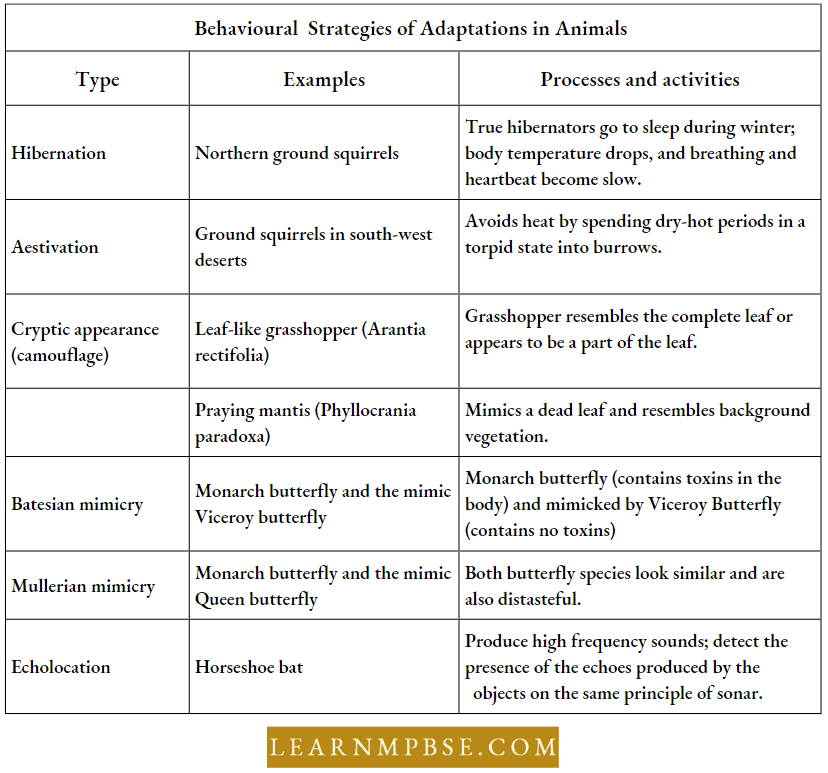
NEET Biology Organisms and Populations Migration
Migration involves long-distance or short-distance movement of animals from one place to another. Many organisms that fly or swim undertake extensive migration as depicted below:
Migration As A Strategy Of Adaption In Animals
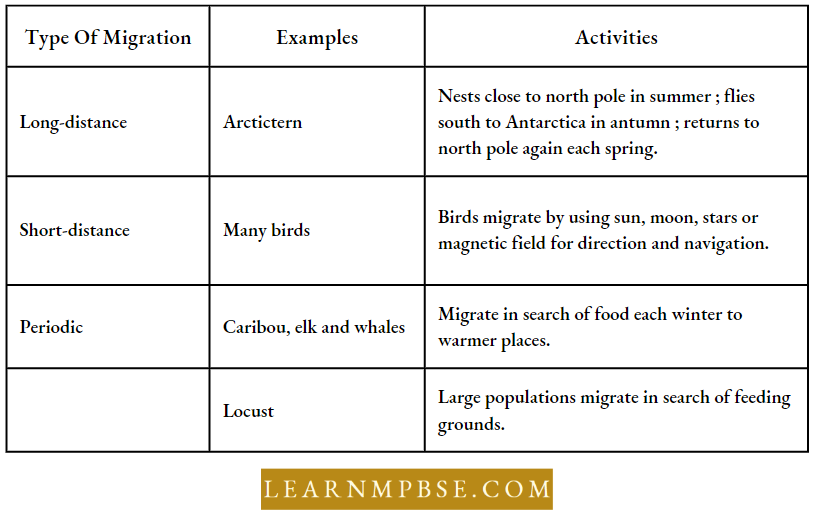
NEET Biology Organisms and Populations Ecads
Ecads are alternatively known as ecophenes. An ecad of a plant species is a group of individuals that, while sharing the same genetic lineage, display notable variations in vegetative traits, such as leaf count on the stem, morphology, and dimensions.
- These differences are solely environmental and thus transient or reversible. A shift from one ecad variety to another may occur due to a change in habitat.
- Thus, the appearance of all ecads would be analogous if they were relocated to the same habitat.
- A multitude of ecads has been recorded across several species. Ramakrishnan (1960) noted that Euphorbia hirta, belonging to the Euphorbiaceae family, exhibits two ecads in India:
- One that thrives in arid, compact soil (prostrate type) and another that flourishes along footpaths subjected to trampling (prostrate compact type).
NEET Biology Organisms and Populations Aquatic Thermal Zonatiqn
Based on temperature, as many as three aquatic strata have been differentiated where the temperature ranges between 5° to 23° C. This stratification becomes distinct in lakes during summer.
Epilimnion. It is the uppermost zone where the temperature decreases gradually.
Thermocline Or Metalimnion. It is the middle short zone where the temperature falls rapidly.
Hypolimnion. It is the lowermost or the bottom zone where the temperature gradients are not distinct. Its temperature may go up to 5° C.
Nocturnal. Active at night (moths, owls, bats, cockroaches).
Diurnal. Active during the day (butterflies, sparrows, crows, pigeons).
Auroral. Active at dawn only.
Vespernl. Active at dusk only. (Rabbit)
Adaptations In Organisms NEET Study Material
Crepuscular. Active at dawn and dusk (Rabbit).
- Long Day Plants Raddish, spinach
- Short Day Plants: Xanlhium, dahlia
- Day Neutral Plants: Tomato
- Desiccation: Transpiration rate exceeds absorption.
- Pyric Factor: It refers to fire.
- Lentic: Pertaining to standing water.
- Lotic: Pertaining to flowing water.
Organisms And Populations Class 12 Notes For NEET
NEET Biology Organisms and Populations Hydrologic Adaptation
On the basis of water requirement and the type of soil, Warming, (1909) differentiated three major and thirteen minor types of plant communities as under:
- Hydrophilous:
- Hydrophytes: Plants living in water,
- Helophytes: Plants living in marsh,
- Xerophilous:
- Oxylophytes: Plants growing on acidic soil,
- Lithophytes: Plants growing on rocks,
- Halophytes: Plants growing on saline soil,
- Psammophytcs: Plants growing on sand and gravel,
- Chersophytes: Plants growing on wastelands,
- Psyehrophytes: Plants growing on cold soil,
- Eremophytes: Plants growing in desert and steppe,
- Psilophytes: Plants growing in savannah.
- Sclerophyllous Formations: Include forests of shrubs and trees having sclerenchyma in the leaves.
- Coniferous Formations: Include forests of conifers.
- Mesophilous:
- Mesophytes: Terrestrial plants growing in normal habitat.
NEET Biology Organisms and Populations Adaptations Of Different Kinds
The ecological adaptation of the three major groups i.e., hydrophytes, mesophytes, and xerophytes shall now be dealt in some detail are as follows.
Hydrophytes: The hydrophytes are generally classified into the following five categories
- Free Floating: for example Lemna, Wolffia, Spirodela, Pistia, Eichhomia etc.
- Submerged Floating: for example Utricularia, Ceratophyllum, Najas etc.
- Rooted Submerged: for example Hydrilla, Vallisneria, Potamogeton etc.
- Rooted With Floating Leaves: for example Nymphaea, Victoria, Trapa, etc.
- Rooted Emergents: for example Ranunculus, Sagittaria etc.
Hydrophytes Morphological Adaptation
- Roots absent (Ceratophyllum, Wolffia ) or poorly developed.
- Root hair is absent in floating forms or poorly developed.
- Root cap absent, root pockets may be present (Eichhomia, Pistia).
- In some forms (Utricularia, Jussiea) floats may be present.
- In a few forms rhizomes (Nymphaea, Nelumbo) or stolons (Pistia, Eichhomia) may be present.
- Stems may be long, thin, slender, and elastic (Hydrilla).
- Leaves may be dissected (Uricularia, Ceratophyllum) or ribbon-shaped (Vallisneria).
- Leaves sometimes with bulbous/swollen base (Eichhomia, Trapa).
- Heterophylly present in emergent forms (Ranunculus, Sagittaria).
Adaptations In Organisms NEET Study Material
Mesophytes: The mesophytes can be classified into two community groups as under
- Herbaceous communities,
- Communities of woody plants.
The former communities are represented by herbaceous flora which is distinguishable into arctic and alpine grasslands, meadows and pastures, and croplands. The communities of woody plants comprise mesophytic bushlands, deciduous forests, and evergreen forests. The evergreen forests include antarctic forests, sub-tropical forests, and tropical rainforests.
The Mesophytes Are Characterized By:
- Root system well developed with distinct root cap and root hair.
- The shoot system is well organized; stems are generally aerial, sometimes underground or sub-aerial.
Xerophytes: The xerophytes are generally described as‘ plants of dry habitat’. They are generally classified into the following three categories
- Ephemeral Annuals. These plants escape dryness externally as well as internally. Hence they are also called ‘Draught resistant’. Argemone indica. Solariumxanthocarpum etc.
- Succulents. They suffer dryness externally but escape internally due to the presence of fleshy water storage tissue for example Opuntia, Aloe, Agave, Euphorbia sp.
- Succulent Xerophytic Plants Are Of the Following Types:
- Chylocaulous stores the water in their succulent stem for example Opuntia, Euphorbia, etc.
- Chylophyllous stores the water in their leaves for example Agave, Aloe, Tradescantia, etc.
- Chylorhizous stores the water in their roots for example Asparagus.
- Succulent Xerophytic Plants Are Of the Following Types:
- Non-succulent. They escape dryness externally as well as internally. They are the true xerophytes, for example, Calotropis procera, Casurina, Acacia nelotica, Zizyphus jitjuba, Capparis apliylla, etc.
On the basis of leaves, the xerophytes are sometimes classified into four groups.
- Microphyllous. They have leaves with very much reduced surface.
- Malacophyllous. They have fleshy leaves.
- Trichophyllous. They have hair on the leaf surface.
- Sclerophyllous. They have sclerenchyma inside the leaves.
Organisms And Their Environment NEET
Xerophytes Morphological Adaptations
- The root system is very well developed, even longer than the shoot.
- Root cap present, root hair extensively developed,
- Stems short, dry, hard, and rough.
- Presence of thick bark.
- Often phylloclades and cladodes are present.
- Leaves may be absent or reduced to spines or scales.
- Leaves usually with reduced surface.
- Stipules are spiny in many species (Acacia, Capparis, Zizyphus).
- Rarely phyllodes are present.
- Leaf surface shiny or hairy.
- Rolling of leaves in some plants.
Halophytes: Plants growing on saline soil are called as halophytes. On the basis of salt contents, they have been divided into three categories by Inveron, 1936 as under
- Oligohalophytes. They grow where NaCI concentration ranges between 0.01 to 0.1%,
- Mesohalophytes. They grow where NaCI concentration ranges between 0.1% to 1.0%
- Euhalophytes. They grow where NaCI concentration is 1.0% or more.
The Angiospermic Coastal Halophytes Are Of Two Types;
- Hydrohalophytes. They remain in the water.
- Hygrohalophytes. They are low coastal types.
- Swamp halophytes
- Marsh halophytes
The Halophytes Are Classified As Under.
- Lithophilous. They grow on rocks.
- Pssamophilous. They grow on sand.
- Psilophilous. They grow in savannah.
- Halophilous. They occur in saline soil.
Halophytes Adaptations
- Presence of shallow root.
- Presence of necrotrophic roots.
- Root buttresses-shaped.
- Leaves thick, succulent.
- Show viviparous germination.
- Presence of thick cuticle.
- Root cover of star-shaped cells.
- Thick-walled hypodermis.
- Aerenchyma present.
- Sclereids and H-shaped spicules are present.
- Vascular tissue is well developed.
- Multilayered cork in roots.
- Leaves generally hypostomatic
- Mesophyll is well differentiated.
- Water-storing tissue extensively developed.
- Presence of sunken stomata.
- Possess low chlorophyll contents.
- Show a high rate of transpiration.
Some of the common halophytes are Spertina altemilora, Aegiceras majus, Avicennia, officinalis, Rhizophora mucronata etc.
Cryptophytes (Geophytes ). Plants grow below the soil with underground buds such as bulbs and rhizomes. They are found in arid zones.
Hemicryptophytes. Perennial plants with buds in or just below the soil surface. Examples. Most of the biennial and perennial herbs.
Chasmophytes. Plants growing in rock crevices.
Calciphvtes. Plants usually grow in soil rich in calcium for example Euphorbia, and Lindernbergia.
Adaptations In Organisms NEET Study Material
Chamaeophytes. Surface plants with prostrate habitats have buds on the surface of the ground.
Annual Ephemerals. Plants that are capable of withstanding adverse conditions in the form of seeds.
Cryophytes. Plants growing on ice: Rhododendron, Betula. (Cushion-shaped dwarf shrubby vegetation)14500 feet up-ward—Snow line.
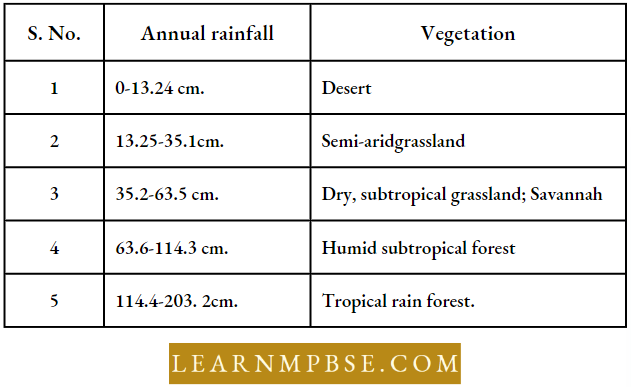
Organisms And Populations Class 12 Notes For NEET
Types Of Vegetation On The Basis Of Rainfall
- Forests. Moderate to heavy rainfall occurring throughout the year in warm tropics produces evergreen rainforests. Heavy rainfall occurs in 7-8 months a year and produces deciduous forests. Areas having little summer but sufficient winter rainfall produce only scrub forests.
- Grassland. The places receiving high summer rainfall and low winter rainfall develop grasslands, which may be of two types.:
- Prairie. A tract of grassland without any trees is called a prairie.
- Savannah. A grassland with scattered trees is called a savannah.
- Desert. Deserts develop in places having very low summer and winter rains.
NEET Biology Organisms and Populations Biological Rhythms Are Of 3 Types
Circadian Rhythms for example opening and closing of stomata, nyctinastic movements, etc.
Tidal/Lunar Rhythms are associated with some particular moon phase for example, Spawning in Nereis, a menstrual cycle of 28 days in the human female.
Annual/Seasonal Rhythms are associated with some specific season of the year for example, hibernation in winter, aestivation in summer, shedding of leaves, flowering, etc.
NEET Biology Organisms and Populations
Biotic Community: It is a grouping of different but interdependent and interacting populations of different species that live together in a given locality. For example, pond community forest community
Population: In ecology, it is a group of individuals of the same species inhabiting the same area and functioning as a unit of a biotic community. or
- It is a unit of a biotic community made up of a near-permanent group of interbreeding individuals of a species found in a particular area at a given time.
- Although the term interbreeding is applied for sexual reproduction, a group of individuals produced from even asexual reproduction is also considered as population, for example, all the cormorants in wetlands, all rats in an abandoned dwelling, teakwood trees in a forest tract, bacteria in a culture plate and lotus in a pond.
- Natural selection operates at the population level to evolve the desired traits, although, it is the individual organism, who has to cope with the changed environment.
- A population has certain qualities that an individual organism does not have. For example, individuals may have deaths and births but the population has birth rates and death rates.
- Population ecology is, therefore, an important area of ecology, because it links ecology to population genetics and evolution.
Important Characteristics/ Attributes Of A Population Are
- Birth Rate (Natality): It is expressed as an increase in a number of births with respect to a number of individuals in a population. for example, If in a pond there were 20 lotus plants last year and through reproduction 8 plants are added so the current population is 28 then the birth rate is 8/20 = 0.4 offspring per lotus per year.
- Death Rate (Mortality): It is expressed as a decrease in the number of deaths with respect to the total number of individuals in the population. for example, If 4 individuals in a laboratory population of 40 fruit flies died during a specified time interval (say a week) then the death rate in the population during that period is 4/40 = 0.1 individual per fruit fly per week.
- Sex Ratio: An individual has sex (male or female) but a population has sex ratio (for example 60% of the population are females and 40% males).
- Age Distribution: Various groups in the population determine its reproductive status.
- Three ages are referred to as ecological ages
- Pre-reproductive
- Reproductive
- Post-reproductive
- Three ages are referred to as ecological ages
- Age Pyramids: A graphic representation of different age groups found in a population with pre-productive groups at the base, reproductive ones in the middle, and post-reproductive groups at the top is called age pyramid. Depending upon the proportion of age groups we have three types of population and pyramids.
- Growing/Expanding Population (Triangular Age Pyramid): When a number of pre-reproductive individuals form the largest group. It shows positive growth.
- Stable Population (Bell-shaped Age Pyramid): When a number of pre-reproductive individuals in almost equal to reproductive individuals. Population growth is zero.
- Declining Population (Urn-Shaped Age Pyramid): When a number of reproductive individuals is more than the number of pre-reproductive individuals. A number of post-reproductive individuals are also sizeable. It shows negative growth.
- Carrying Capacity (K): The maximum number of individuals of a population that can be sustained indefinitely in a given habitat, represents its carrying capacity. At K, the growth rate is equal to zero, Beyond K, population size decreases.
- Biotic Potential Vs Environment Resistance: An environmental check on population size or its biotic potential, is called environment resistance. Environmental resistance represents the limiting effect of abiotic (i.e. H2O and space) and biotic factors (i.e. food and competition) that do not allow the organization to attain its biotic potential and keep the population size at a much lower level.
- Environmental resistance = \(\frac{K – N}{K}\).
- Population Size: The size of the population is dependent upon the outcome of competition with another species, the impact of the predator, or the effect of the use of pesticides.
- Population size also called population density, (designated as N) is generally measured in numbers or in percent cover or biomass, per unit area for example with respect to number it can be as low as 10 (Siberian cranes at Bharatpur wetlands in any year) or go into millions (Chlamydomonas in a pond).
- Although the total number is the most appropriate measure of population density, in some cases, it may not depict the correct role of a species in a large community. for example in a forest area, if there are 200 Parthenium plants and only one Banyan tree with a large canopy, we cannot say the population density of Banyan is low.
- In such cases, percent cover or biomass is taken as a measure of population size.
- If the population is large and counting is not possible, then relative densities are taken into consideration.
- for example number of fish caught per trap is a good enough measure of the total population density in the lake.
- Sometimes population size is indirectly estimated without actually counting them.
- The Tiger census in National Parks and tiger reserves is often based on pug marks and fecal pellets.

NEET Biology Organisms And Populations
Adaptations In Organisms NEET Study Material
Population Growth: The size of a population for any species keeps changing in time, depending on various factors including food availability, predation pressure, and changing weather conditions.
These changes in the population density give some idea of whether it is flourishing or declining. The density of a population in a given habitat during a given period fluctuates due to changes in four basic processes, two of which (natality and immigration) contribute an increase in population density and two (mortality and emigration) to a decrease.
- Natality: Refers to the number of births during a given period in the population that are added to the initial density.
- Mortality is the number of deaths in the population during a given period.
- Immigration is the number of individuals of the same species that have come into the habitat from elsewhere during the time period under consideration.
- Emigration is the number of individuals in the population who left the habitat and went elsewhere during the time period under consideration.
So, if N is the population density at time t, then its density at time t + 1 is Nt+1 = Nt+ [(B + 1)-(D + E)]
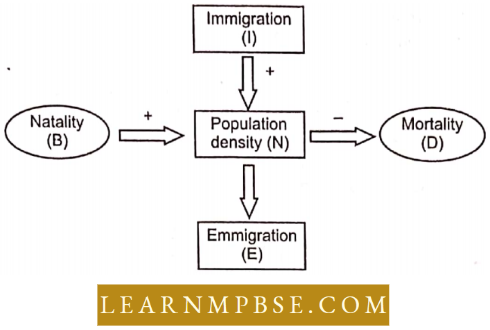
Under normal conditions, birth and death are the most important factors influencing population density, the other two factors, assuming importance only under special conditions, for example, if a new habitat is just being colonized, immigration may contribute more significantly to population growth than birth rates.
Growth Models: The growth of a population with time shows specific patterns resulting in different types of growth forms. These are
1. Exponetial Growth/J-growth Form: When food and space for a population are unlimited, each species has the ability to realize fully its inherited potential to grow, as Darwin observed while developing his theory of natural selection. Then the population grows in an exponential or geometric ratio.
If in a population of size N, the birth rates (not total number but per capita births) are represented as b and death rates (per capita death rates) and d, the increase or decrease in N during a unit period t(dN/dt) will be dN/dt = (b-d)xN
Let (b-d) = r, the n dN/Dt = rN
The r in this equation is called the intrinsic rate of natural increase and is a very important parameter selected for assessing the impacts of any biotic or abiotic factor on population growth. example, for the Norway rat the r is 0.015, and for the flour beetle is 0.12.
In 1981 the r value for the human population in India was 0.0205.
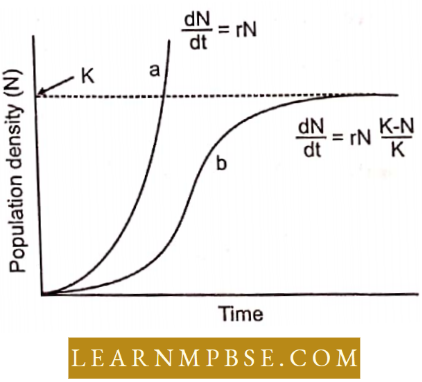
The above equation describes the exponential or geometric growth pattern of a population and results in a J-shaped curve when we plot N in relation to time.
We can derive the integral form of the exponential growth equation as Nt = N0 ert
Where,
Nt = population density after time t
N0 = population density at time zero
r = intrinsic rate of natural increase
e = the base of natural logarithms (2.71828)
Population Growth Models NEET Exam Preparation
Any species growing exponentially under unlimited resource conditions can reach enormous population densities in a short time. Darwin showed how even a slow-growing in animal like an elephant could reach enormous numbers in the absence of checks.
2. Logistic Growth, S-Shaped, Or Sigmoid Growth Form: In nature, populations do not have unlimited resources at their disposal. This leads to competition between individuals for limited resources. So in nature, exponential growth usually is not common.
- Many countries have realized this fact and introduced various restraints to limit human population growth. In nature, a given habitat has enough resources to support the maximum possible number, beyond which no further growth is possible.
- This limit is called as nature’s carrying capacity (K) for that species in that habitat. A population growing in a habitat with limited resources shows initially a lag phase, followed by a phase of increase (log phase) and decrease (declining phase), and finally, the population density reaches the carrying capacity (Stationary phase, Asymptote).
- A graph of N in relation to time (t) results in a sigmoid curve.
This type of population growth is called Verhulst-Pearl Logistic Growth as explained by the following equation
dN/dt = rN (\(\frac{K-N}{K}\))
where N = Population density at time t
r = intrinsic rate of natural increase
K = Carrying capacity
Since resources for growth for most animal populations become limited sooner or later, the logistic growth model is considered a more realistic one.
Life history Variation: Populations evolve to maximize their Darwinian fitness (high r-value) in their habitat. It is known that in nature
- Some species live very long (for example, humans) some only for a short time (for example insects),
- Some breed only once in their lifetime (for example pacific salmon fish, bamboo) while others breed many times during their lifetime (for example, most birds and mammals,
- Some produce a large number of small-sized offspring (for example, oysters, and pelagic fishes) while others produce a small number of large-sized offspring (for example birds, and mammals).
- Ecologists suggest that life history traits of organisms have evolved due to the restrictions imposed by the abiotic and biotic components of their habitat.
Population Interactions: In nature animals, plants, and microbes cannot live in isolation, but interact in various ways to form a biological community. Three types of factors govern the ecological interaction amongst different populations of a biotic community i.e.
- Requirement and mode of obtaining food.
- Type and area of shelter.
- Habits of different populations.
Interspecific interactions arise from the interactions of populations of two different species.
These could be
- Beneficial (+ ve)
- Detrimental (-ve)
- Neutral (0)
All types of interactions have been called symbiosis by DeBary. (Later on, the term symbiosis became synonymous with mutualism).
Organisms And Populations Class 12 Notes For NEET
NEET Biology Organisms and Populations Interaction
Positive Interaction. Commensalism, proto-co-operation, and mutualism arc the interaction between two different species and limit the growth and distribution.
Negative Interaction. Amensalism, parasitism, predation, and competition are the negative interactions that govern the growth and distribution.
Neutral Interaction. In which neither of the two species is benefited nor harmed. According to Me Dougal symbiosis when conjunctive type (permanent) may be social or nutritive. When it is of disjunctive type (non-permanent) also it may be social or nutritive, The nutritive type may be antagonistic or reciprocal.
Clark differentiates symbiosis and antagonism as two distinct types of relationship. Burk Holder, however, differentiates at least nine types of relationships such as neutralism, competition (direct interference/resource use types), amensalism, parasitism, predation, commensalism, protocol operation, and mutualism.
NEET Biology Organisms and Populations Predation
It is a direct biological relationship between two species wherein one species (the predator) lethally consumes the other species (the prey) for sustenance. Consequently, a predator-prey dynamic exists.
- Insectivorous plants, including Drosera, Utricularia, Dionaea,
- Aldrovanda, Pinguicula, Nepenthes, Sarracenia, Cephalotus,
- Darlingtonia, and Heliamphora, exemplify predation effectively. These plants consume insects and microorganisms to address their nitrogen shortage.
- Herbivores consume not only herbs but also shrubs and trees. The plants are adversely affected to varying extents by grazing and browsing.
- Annuals endure more intensive grazing compared to perennials.
- Selective grazing results in an increase in the prevalence of unpleasant, thorny, and shrubby plants.
- Consequently, biodiversity is diminished. This also diminishes the humus content of the soil.
- Nevertheless, grazing and browsing contribute to a notable rise in soil nitrogen levels through the deposition of excreta from grazing animals. A frog functions as both a predator and prey.
Population Growth Models NEET Exam Preparation
Interactions Amongst Different Species
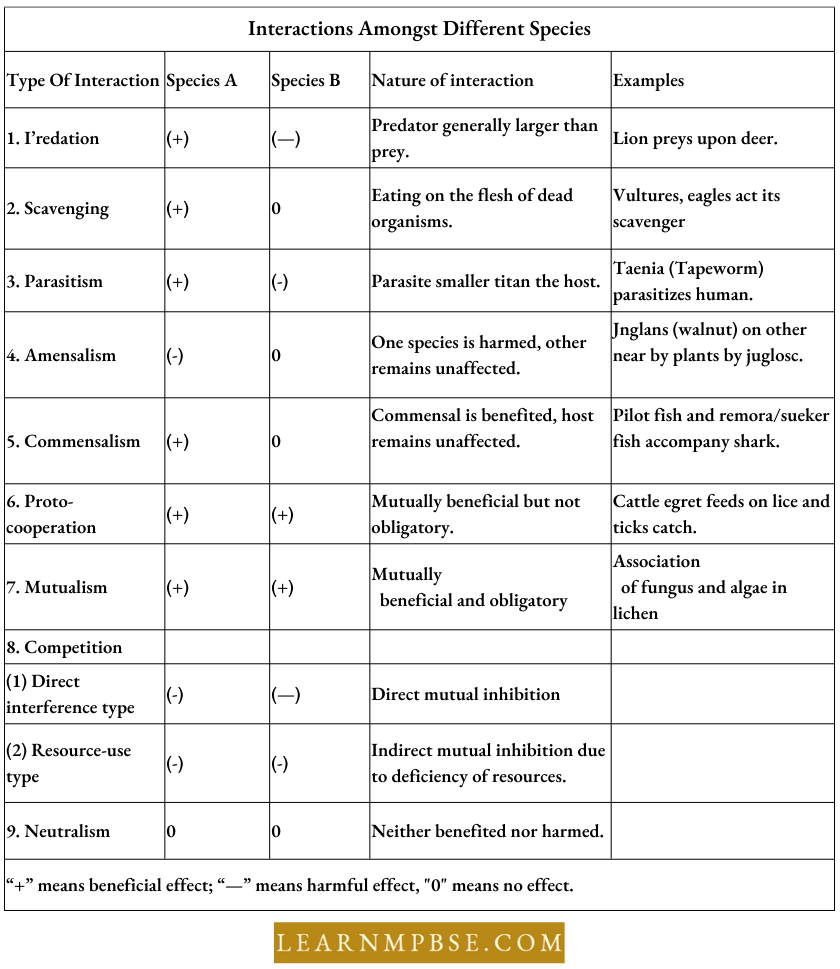
NEET Biology Organisms and Populations Scavenging
Is also a direct relationship where an animal feeds on another dead animal that has died naturally or has been killed by another animal.
NEET Biology Organisms and Populations Parasitism
It is a relationship between two species in which one (parasite) is nearly dependent on the other (host) and may cause disease.
Characters Of Parasites
- Small size population.
- They are host-specific.
- they have higher biotic potential.
- They have poor means of dispersal and require special structures to reach or invade the host.
- They alter the population growth of the host.
- They cause weakness in the host.
The gainer is called a parasite and the loser is the host. The host is always larger than the parasite. On the basis of the position of the host, the parasites are classified into two categories ectoparasite and endoparasite. The endoparasite lives inside the host whereas the ectoparasite lives on the surface.
- The parasitism may be total or partial. The former remains a parasite throughout its life and is wholly dependent whereas the latter is only partly dependent upon the host showing a tendency towards free living. On the basis of their location on a specific body part, the parasites have been categorized as stem, root, or leaf parasites.
- The plants of Cuscula are total stem parasites whereas those of Orobanche, Rafflesia, Balanopliora, etc. are total root parasites. The partial stem parasites are Dendrophoe, and Viscum whereas Santalum and Thesiiun are partial root parasites.
Numerous fungi (Albugo, Puccinia, Ustilago, etc.), bacteria (Xanthomonas, Pseudomonas, Mycobacterium, Vibrio, Leptospira, etc.), and viruses are parasites on plants and animals. In the same way, several protozoans (Plasmodium, Entamoeba, etc.), flatworms, tapeworms, and roundworms live as endoparasites on other animals. A few insects occur as ectoparasites on other animals. Besides, these ectoparasites may carry fungi or bacteria as hyperparasites.
- Parasite. An organism that lives in or on another organism of different species from which it derives its nutrition.
- Parasitism. It is an association between two species where one is benefited and the other is harmed.
- Sometimes a parasite is further parasitized by another parasite and the phenomenon is called hyperparasitism for example Nosema notabilis (a sporozoan) is an obligatory parasite of Sphaerospora polymorph (a protozoan) which in turn is a parasite of the urinary bladder of toadfish.
- Social Parasitism is another interesting kind of parasitism in which one species is exploited by another species for some benefit for example cuckoo lays its eggs in the nest of a crow, leaving the eggs and the young in the care of foster parents. About 1% of all birds are brood parasites.
- Sexual Parasitism. In Photocorynus (Angler fish) male lives as a tiny permanent parasite on the head of the female and depends upon her blood supply.
- Parasitology. Study of parasites.
- The Rufus woodpecker, (Micropternus brachyurus) nests in a hole excavated in the ball-shaped nest of Crematogasler (the red ants). The eggs, young, and adults of the birds do not suffer from the ferocious ants moving in the nest. The birds live on these ants. This can be said to be nature’s way of keeping the ant population within limits.
- Biological Control. Controlling the population of harmful organisms by means of their natural predators, parasites, or pathogens for example Cactoblastis (cochineal insect) to control Opuntia; woodpecker (Micropternus) to control red ant; Zygogramma (beetle) to control Parthenium weed; Gambusia (minnow fish) to control mosquito larvae, etc.
- Smoother Crops. Crops that do not allow the weeds to grow in the fields for example Sunflower, Barley, Rye, Soyabean, Millet, etc.
NEET Biology Organisms and Populations Commensalism
It is an association of two species in which one lives attached to another but does not harm it. One who is benefited is called commensal.
Organisms And Populations Class 12 Notes For NEET
NEET Biology Organisms and Populations Mutualism
It is a relationship between two species or organisms where both partners are benefited from each other.
Mutualism Examples
- Lichens. It is an association between fungi (protrusion, fixation, and absorption) and algae (food) which is sometimes described, as Consortium.
- Zoophily. Several types of animals are involved in the pollination mechanism. Many insects such as bees, moths, butterflies (entomophily), and birds (ornithophily) are involved in the pollination of (lowers when they visit them for food in the form of nectar.
- Zoochory. Several animals bring about the dispersal of seeds when they visit plants in search of food. A reference of all such plants may be given here whose seeds are dispersed by birds or mammals. They possess several specific anemochorous adaptations in their seeds or fruits.
- Mycorrhiza. The fungal mycelium found associated to the ‘roots’ of higher plants, the Mycorrhizae are also good examples of mutualism. It may be ‘ectotrophic or endotrophic’. The fungal partner gets food and shelter from the roots of higher plants and their hyphae substitute for the root hair of the host, thus helping in absorption.
Ecological Succession Stages NEET Biology
The mutualistic association is also seen in between many organisms for example, between alga Aphanocapsa and Ircinia, alga Zoochlorellac and flagellate Zooxanthellae and Hydra, and alga Zoochlorellae and Paramecium are worth mentioning. The alga protects the host cell by providing it with food and oxygen. In return, it gets protection.
NEET Biology Organisms and Populations Amensalism
It is a relationship in which one population is adversely affected while the other stays unscathed. The detrimental effect is attributable to certain molecules known as allochemics. There are three categories: allomones, kairomones, and depressants.
- Allomones are chemicals that confer adaptive benefits to the organism that emits them, such as the ink emitted by the mollusk Loligo.
- Kairomones are compounds that confer an adaptive benefit to the recipient population, such as those emitted by some nematodes that promote the growth of specific fungi.
- Depressants are substances secreted by an organism that lethally affect the receiver population.
- The alga Microcystis secretes hydroxylamine, which exterminates the adjacent fauna while remaining impervious itself.
- Antibiosis. A relationship between two species that is detrimental to one of them. For instance, allelomorphy.
NEET Biology Organisms and Populations Protocooperation
It is a type of relationship that is beneficial to both partners but it is not obligatory for their survival. This relationship has been also termed by some workers as non-obligatory mutualism. Some large birds nest on the lower branches whereas the small ones live much higher. These large birds protect the small ones from tree-climbing predators.
Examples Of Competition
- Frank (1957) Daphnia pulicaria causing the extinction of D. magna in mixed cultures.
- Feeding behavior of cormorant (a bottom feeder of flat fish) and shag (a surface feeder of herrings and eels) by Lack (1945).
- Feeding behavior of seven species of millipedes on the forest floor of a maple oak forest by O. Neill (1967).
- Darwin’s finches (14 species of passerine birds) on the Galapagos islands (Lack, 1947).
- Lotka (1925) and Volterra (1926) gave a mathematical model for interspecific competition.
Organisms And Populations Class 12 Notes For NEET
NEET Biology Organisms and Populations Mimicry
The phenomenon in which a particular harmless species of animal shows similarity to another species of animal which is dangerous, poisonous, or distasteful so to avoid its enemies.
Kinds Of Mimicry
- Protective mimicry
- Carausius morasus (stick-insect or walking stick) The body and body appendages are long, slender like thin and dry branches.
- Phyllium frondosurn (leaf-insect). The body is flat and green like a leaf.
- Kallima paralecta (dead-leaf butterfly). The body looks like a dead and dry leaf when it rests on an oak tree.
- Cryptolithodes (white crab) resemble the white pebbles.
- Phyllopteryx (Australian sea horse) produces leafy outgrowths like seaweeds.
- Aggressive Mimicry
- Concealing types or aggressive mimicry for example yellow spider (predator) sitting on marigold flowers is invisible to insects (prey).
- Alluring type or aggressive mimicry for example the comer of an African lizard resembles a flower.
- Ophyrous flowers resemble female wasps and thus get pollinated by male wasps.
- Feigning death or Conscious mimicry.
- Stimulation Of Dkatii (Conscious Mimicry): Certain animals exhibit eonseimis imitation on the approach of danger and behave as if they are dead bodies. A few examples are cited below:
- American Opossum ‘Diddphis virginiam’ becomes unconscious and simulates as dead.
- Haiti-bodied beetles fall down like pebbles when they are about to be seized by the enemy.
- Stimulation Of Dkatii (Conscious Mimicry): Certain animals exhibit eonseimis imitation on the approach of danger and behave as if they are dead bodies. A few examples are cited below:
- In Warning Type Protective Mimicry. The mimic resembles a distasteful or poisonous organism example, a palatable species of Viceroy butterfly (Bosilarchia archippus) resembles a distasteful Morarch utterly Donasais platypus) also termed Halesian mimicry.
- In Mullerian mimicry. Two or more unpalatable and related species resemble each other.
- Examples Of Mimicry
- Elephants and rhinos have colors similar to tree trunks and mud.
- Lions and camels are sand colored.
- Praying mantis, tree frog hyla. Grasshoppers are green in color.
- Jellyfish and sea cucumbers are glassy.
- Chameleons is able to change their color according to the background.
- Camouflage. The color pattern of animals blends with their environment so as to minimize the risk of predation.
- Conditions Necessary for Mimicry
- The necessary conditions for the occurrence of protective mimicry have been analyzed by Wallace and are listed below:
- The mimics of the imitative species occur in the same area which are occupied by the models.
- Mimics are always or more often defenceless and they mimic the offensive or harmful animals.
- Mimics are always fewer in number than the model individuals so the deceived animal encounters the mimics less often than the model.
- The imitators should differ from their allies.
- Even if the imitation is minute, it should be external and visible.
- Examples Of Mimicry
Ecological Succession Stages NEET Biology
NEET Biology Organisms and Populations Significance Of Mimicry
The main significance of mimicry appears to be the protection of individuals against enemies. This self-defense is naturally of survival value and of evolutionary significance. It means natural selection which is supposed to be one of the most important factors in evolution, favors mimicry since it assures better survival and greater success in the multiplication of race.
NEET Biology Organisms and Populations Polymorphism
The colony is formed of two types of individuals who differ in structure function or behavior.
- Apis indica. Colonial, Social insect. Queen, Workers or Drones.
- Termite, White Ant (Microtreme) have 5-caste:
- Queen
- Workers
- Nasutes
- Drones
- Soldiers
- Portuguese Man Of War (Physalia) has zooids that show polymorphism
- Dactylozooids – for defence,
- Gastrozooids – for feeding.
- Gonodendra – for reproduction.
- Pheumatophore – for floating.
- Obelia – Trimorphic coelenterates:
- Polyp – for nutrition.
- Blastostyle – for Medusae formation.
- Medusa – for sexual reproduction.
- Volvox (colonial protist) – Formed of about 500-60,000 cells.
- Peripherally located vegetative zooids (with flagella)-For locomotion and nutrition.
- Internally located reproductive zooids for multiplication.
- Show polymorphism in their flower coloration
- Lathyrus odoratus – Sweet Pea
- Rosa indica – Rpse
- Violva tricolor – Pans
Differences Between Climate And Weather
Microclimate. It represents the climatic conditions that prevail at a local scale or in an area of limited size.
Environment. The sum total of all the biotic and abiotic factors that surround and potentiality of the environment serve as a resource, while others act as regulatory factors.
Habitat is the native environment of an animal or place.
Niche. The position or function of an organism in a community of plants and animals.
Landscape. It is a unit of land with a natural boundary having a mosaic of patches.
Individual Organism, is the most concrete and easily ob-servable unit in the environment because it is a distinct package carrying out life processes within its body as a distinct entity.
Acclimatization. The gradual physiological adjustment to slowly changing new environmental conditions is known as acclimatization. If some factors shift beyond the tolerance range of an organism, the organism can continue to the resting stage, migrate, or it can acclimatize.
Ectotherms (Cold Blooded Animals). The body temperature changes along with the change in environmental temperature. Frogs and snakes control their body temperature by moving around or seeking shade or undergoing hibernation.
Endotherms. They regulate their body temperature by physiological means and maintain a constant temperature Irrespective of changes in the temperature of surroundings, Birds and mammals have physiological mechanisms for keeping the body temperature constant.
Salinity is due to the accumulation of soluble minerals on the surface or beneath the surface of the earth.
- The permeability of soil is due to the colloidal nature of the soil.
- Plants die in water-logged soils due to the absence of air. Yak is adapted to very cold temperatures.
- The natality rate (birth rate) number of individuals born per 1,000 individuals of a population per year.
Ecological Succession Stages NEET Biology
Changes In Population Are Expressed As Follows:
Nt = N0 + B + I – D – E
Nt = Increase in size
N0 = Initial size
B = Natality rate
I = Hate of immigration
D = Mortality rate
E = Rate of emigration.
J-shaped and S-shaped are the two forms of growth curves.
J-shaped growth curve is represented as \(\frac{d N}{dt}\) = rN
⇒ \(\frac{d N}{dt}\) = rate of change in population size
r = Biotic potential
N = Population size
Equation For S-Shaped Growth Curve: \(\frac{d N}{dt}\) = iN(\(\frac{k -N}{K}\))
k – N/k or 1 – \(\frac{N}{k}\)
NEET Biology Organism And Environment Species And Population Synopsis
Swell Wright Effect. Also called Genetic drift. It is the change in gene frequency due to random fluctuations in small isolated populations causing certain alleles to be lost while other alleles become more evenly distributed.
Schrveter and Kirchner coined the terms autoecology and synecology.
- Ecology = Environmental biology
- Term Bioccology was used by Shelford and Clements for the study of both plant and animal ecology.
- Pheromones. 3 types—Primer Pheromone (example, Locustrol), Rcleaser pheromone (for example, Alarm hormone of worker ant), and Informer pheromone (provides information example, trail substance).
- Population with an equal number of births and deaths shows a plateau phase.
- Competition is severe in a population that has an irregular distribution
- Carrying capacity does not directly affect the biotic potential.
- Cross-fertilization is a kind of cooperative interaction among animals
- Population dynamics. Study of changes in growth and density of population in relation to various parameters.
- The country with negative growth is Austria.
- Amphimictic population. The population whose members reproduce sexually.
- Apomictic population. The population whose members reproduce asexually.
- International Literacy Day falls on 9th September.
- Toxicology: a term used by Mivort for ecology.
- Ethology: the term was used in Hilaril for ecology.
- Insect society is a product of instinctive behavior and Biological evolution whereas the human population is a product of learned behaviour.
- In aquatic organisms, population density is expressed in cubic meters/cubic centimetre
- Rats do not have any fixed partners
Major Biomes With Respect To Annual Temperature And Precipitation
- Deserts
- Grasslands
- Arctic and alpine tundra
- Tropical forests
- Temperate forest
- Coniferous forests.
Major Biomes Of India (Key Conditions: temperature, light, water and soil)
- Deserts (Rajasthan and parts of Gujarat)
- Tropical rainforests (Northeastern states)
- Sea Coast
- Deciduous forests
- Torrential stream
- Permafrost polar regions
- High mountain tops
- Boiling thermal springs
- Stirling compost pits.
Major Abiotic Factors
- Temperature
- Water
- Light
- Soil
- Air
- Rainfall
- Humidity
Response To Abiotic Factors: To maintain the constancy of the internal environment.
- Regulate
- Confirm
- Migrate
- Suspend
Adaptations: They enable the organism to survive and reproduce
Populations:
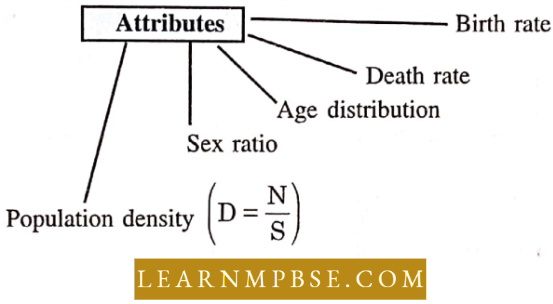
Population Growth:
- Natality
- Mortality
- Immigration
- Emigration
Exponential Growth: J-Shaped Growth Curve
⇒ \(\frac{d N}{dt}\) = (b-d)N-S
Let (b-d) = r then \(\frac{d N}{dt}\) = rN
Logistic growth (S-shaped growth curve) \(\frac{d N}{dt}\) = rN (\(\frac{K -N}{K}\))
N = Population density at time
r = intrinsic rate of natural increase,
K = carrying capacity
Population Interactions
- Mutualism – Lichens, Mycorrhiza
- Commensalism – Orchid growing on mango tree, Sea anemone and clown fish
- Amensalism – Penicillium does not allow growth of Staphylococcus
- Predation – Starfish piaster, Prickly pear cactus
- Parasitism – Liver fluke parasite on snails and fish.
- Competition – Larger superior Barnacle Balanus dominates smaller Barnacle Chethamalus in the intertidal area.
